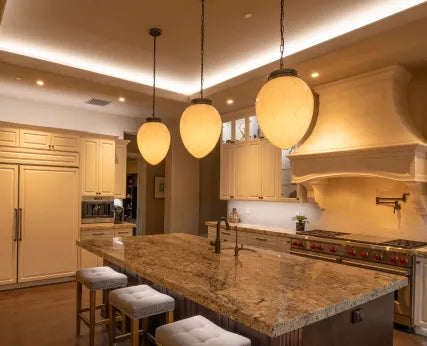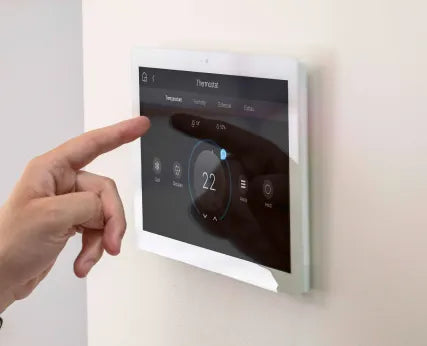From Connected to Smart: The Ultimate Guide to Complete Home Automation Solutions
Imagine a home that anticipates your needs. Before you even arrive, your smart thermostat adjusts your home's temperature to the perfect setting. As you approach, your smart locks unlock automatically and smart lighting gently illuminates your entryway, creating a warm and inviting atmosphere. Just say “movie night,” and the lights dim, curtains close, and the TV turns on. This isn’t futuristic fiction—it’s the reality made possible by comprehensive home automation solutions.
A “smart home” is no longer just about having a few smart devices controlled by a mobile app. It has evolved into a complete, coordinated ecosystem that makes your home safer, more efficient, and more comfortable. But what truly differentiates a jumble of gadgets from a genuinely intelligent home automation system?
The answer is integration. A robust solution seamlessly connects all your devices and enables them to work together, creating a truly automated living experience. This guide will dive deep into everything you need to know to transform your home into a smart, responsive, and proactive partner.
What Are Home Automation Solutions?
At its core, a home automation solution is an integrated system that connects all your home’s electronic devices and appliances to a central network. This enables them to communicate with each other and perform tasks automatically based on predetermined rules, schedules, sensor data, or even your real-time location.
The heart of this system is the home hub and communication protocols like Zigbee, Z-Wave, and the emerging Matter standard. These technologies create a reliable network, allowing various devices—such as lighting, locks, thermostats, and smart cameras—to operate as a unified whole.
Unlike operating each device manually, a complete solution can:
- Determine if you’re home using occupancy sensors or geofencing (based on your smartphone’s location).
- Execute “scenes” or “routines,” like a “Good Night” scene that can turn off all the lights, lock the doors, and adjust the thermostat with a single action.
- Respond to your commands via voice control assistants such as Alexa or Google Assistant.
- Proactively manage energy efficiency by turning off devices you’re not using, helping to reduce costs.
In short, it’s an all-encompassing solution that transforms your home from a passive space into an active, responsive environment.
Why Choose Automation: Core Benefits
Investing in a comprehensive home automation solution pays dividends beyond convenience. It delivers profound value for both homeowners and property managers.
- Unmatched Comfort and Convenience: Automation handles the mundane tasks of daily life, such as closing curtains at sunset or simulating occupancy with lights while you’re on vacation.
- Significant Energy Savings: Intelligent management of lighting, heating, and cooling can dramatically lower utility bills. The system prevents heating or cooling empty rooms and can optimize EV charging times to take advantage of off-peak rates.
- Enhanced Home Security: Integrated smart locks, smart cameras, and sensors work together as an active home security network. When abnormalities are detected, the system not only sends you alerts but can also automatically turn on all lights and sound alarms.
- Quality of Life Improvements: From improving indoor air quality through ventilation management to creating immersive whole-home audio experiences, automation elevates your living environment in every way.
- Care and Accessibility: For seniors or those with limited mobility, voice control and automated routines can greatly boost independence and safety.
Core Components of the Solution
A powerful home automation solution consists of several essential pieces.
- Home Hub & Protocols: Serving as the system’s brain, the home hub coordinates all devices. Protocols like Zigbee, Z-Wave, Wi-Fi, and Matter serve as the languages these devices use to communicate.
- Reliable Networking: A stable, robust Wi-Fi network forms the foundation for all wireless smart devices to work seamlessly.
- Smart Devices: These are the “hands and feet” of the system, including:
-
- Smart Lighting: Control brightness, color, and timing.
- Smart Thermostats: Optimize heating and cooling.
- Smart Locks and Doorbells: Remotely manage access and see visitors.
- Smart Cameras: Offer real-time surveillance and intelligent alerts.
- Smart Shades/Blinds: Automatically adjust based on time of day or sunlight.
- Sensors: Detect motion, door/window opening, water leaks, and smoke.
Top Use Cases: Automation Integrates with Everyday Life
The real magic of home automation solutions lies in how seamlessly they adapt to every part of your life.
Comfort and Convenience
Imagine a “Good Morning” routine: Fifteen minutes before you wake up, the curtains softly open, the thermostat turns up, the coffee maker starts brewing, and your news briefing plays through a smart speaker.
Security and Protection
When you leave the house, the system automatically locks doors, arms security, and turns off unnecessary lights. If a smart camera detects unusual activity, it immediately sends an alert to your phone and activates all lights to deter intruders.
Energy Management
The system can smartly manage energy use based on your presence, time of day, or even real-time electricity prices. For example, a smart irrigation system can check weather forecasts and skip watering on rainy days, saving water.
Entertainment Experience
With a single tap on your “Movie Night” routine, you can dim the lights, lower the projection screen, and start the audio system—perfect for the ultimate cinematic environment. Whole-home audio lets your music follow you seamlessly from room to room.
Interactive Prompt: Which automation scene are you most excited to try in your own home: “Away Mode” or “Movie Night”?
Integration and Interoperability: Making Everything Work Together
In the past, devices from different brands rarely talked to each other. Fortunately, that’s changing.
- Matter: This emerging industry standard aims to make smart devices from different manufacturers work together seamlessly, greatly simplifying setup and expansion.
- Zigbee/Z-Wave: Two established low-power wireless protocols designed for smart home devices, creating stable mesh networks.
- Wi-Fi: Many devices connect directly to your Wi-Fi network for easy installation, but too many devices can overload your network.
Pro Tip: Choose a home hub that supports multiple protocols—especially Matter—for maximum flexibility in future device choices.
Data Privacy and Cybersecurity: Protecting Your Smart Home
As homes become increasingly “connected,” protecting your data and privacy is critical.
- Change Default Passwords: Your first and most important line of defense for every device.
- Enable Two-Factor Authentication: Add another layer of security for your main account.
- Isolate Device Networks: Consider creating a dedicated guest Wi-Fi for all smart devices, keeping them separate from your main network where personal data is stored.
- Regularly Update Firmware: Manufacturers issue updates to fix security vulnerabilities. Keep all your devices up to date.
Checklist: Review your existing smart devices and make sure you’ve set a unique, strong password for each one.
Measuring Return on Investment (ROI)
How do you quantify your investment in home automation solutions? It requires a data-driven framework.
- Key Performance Indicators (KPIs):
-
- Energy Savings: Track the kilowatt-hours (kWh) or gas costs saved.
- Reduction in Security Incidents: Document the decrease in break-ins or water leak events.
- Satisfaction: Measure quality-of-life improvements with Net Promoter Score (NPS) or customer satisfaction surveys.
- Analytics Framework: Compare post-installation data with the previous year’s baseline to calculate a specific ROI. A professional solutions provider can help you set up this framework.
The Future of Home Automation
Home automation technology continues to evolve rapidly.
- Edge AI: More smart decisions will be made locally on devices (not in the cloud), providing faster responses and better privacy.
- Predictive Maintenance: Your home can notify you when it’s time to replace air filters or even alert you before your water heater fails.
- Energy Orchestration: Systems will coordinate more intelligently with the power grid, optimizing when to use solar panels, home batteries, and EVs throughout the day.
Partnering with Linko Smart Technology
Designing and installing a seamless, reliable, and secure home automation system requires professional expertise. From network planning and device selection to advanced scene programming, every step matters.
At Linko Smart Technology, we’re specialists in end-to-end home automation solutions. We start by understanding your lifestyle and needs, create a custom-designed system for you, provide expert installation and configuration, and ensure you can easily enjoy all the benefits of smart living.
Ready to transform your home into a truly intelligent companion? Contact Linko Smart Technology now for a free consultation or to plan your home automation project.
Frequently Asked Questions (FAQ)
1. How much does it cost to deploy a complete home automation solution?
Costs vary greatly depending on the size of your home, the number and brands of devices, and the complexity of automation. You can start with a single room or a specific function (like smart lighting) and expand over time. We focus on providing you the greatest value.
2. Can my old house be retrofitted for automation?
Absolutely. There are plenty of wireless devices and solutions on the market designed specifically for retrofitting existing homes, so you won’t need major rewiring.
3. How long does installation take?
A simple system may only take a few hours. A full-home automation project could take several days depending on its scale and complexity. We will provide a clear timeline.
4. What kind of maintenance is required?
Most modern smart home devices require little to no physical maintenance. The main task is keeping software and firmware updated, which is often automatic via apps—or can be managed remotely by us.
5. Should I choose DIY or professional installation?
If you’re tech-savvy and only want a few standalone devices, DIY is an option. But if you want a fully integrated, reliable system where all devices work together seamlessly, we strongly recommend professional installation. Experts ensure stable networking, device compatibility, and program complex automation scenes so you get the most from your system.
6. Is my personal data and privacy secure?
Your privacy is our top priority. We only work with reputable brands that offer robust cybersecurity features and transparent privacy policies. Our professional installations also include key security measures—like device network isolation and strong passwords—to protect your system from unauthorized access.




